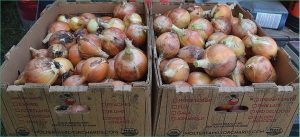Although we did not have an onion variety trial this past season, we did have one small onion project where we took a grower’s onions and applied three foliar applications. Each foliar consisted of 5 pounds/acre 4-18-38. The onions were planted with four lines per bed, with dual drip lines per bed. These foliar applications were all in one bed, and it alternated “control – foliar – control – foliar – control – foliar”. Just prior to harvest the middle of each treatment was estimated and a total of six consecutive onions were pulled from both the outside and a middle line (row).

The 72 non-foliar onions had a harvest weight of 20,711.50 grams, the 72 foliar onions weighed a total of 22,100.50 grams, for a 6.75% increase in harvest weight. Harvest was delayed somewhat due to rain, and there was a small amount of slippery skin present. The control had 5.56% bulbs infected, and the foliar having 2.78% infection. Taking out the diseased bulbs, the foliar treated onions had a 9.90% increase.
Average bulb weight was obviously increased as the number of bulbs being harvested was equal. What was somewhat interesting was that the onions from the middle row had a greater percentage increase than those on the outside row. The bulbs on the outside had a larger average bulb size, perhaps due to either less competition from neighboring onions, or perhaps an increase in available sunshine. A drip line was between the two lines, so any nutrient applied through drip lines should have been equal. This is somewhat of an indication that the onions from the middles benefited more from foliar applied nutrient than the onions from the outside row. This is consistant with earlier projects where foliar results increased, as a percentage, in higher stress situations.
